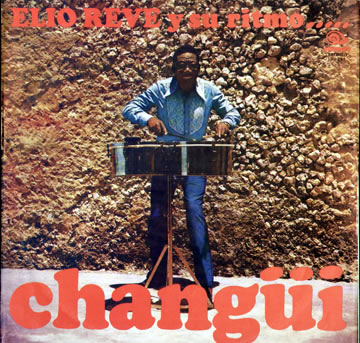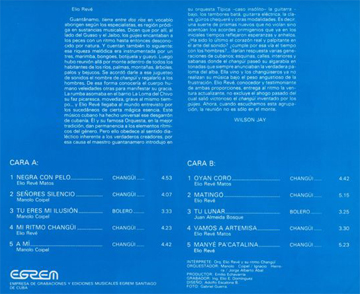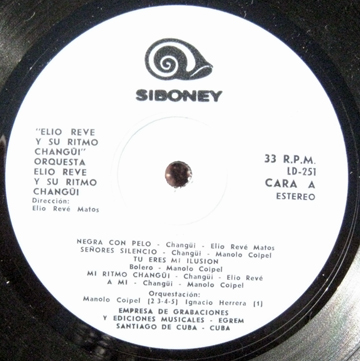Indice - Table of contents
Lo Nuevo[hide]
Grupos: Pupy y los que S... : Discography - 1995- F...
Reportes: From The St... : Cubadisco 2...
Staff: Bill Tilford
Reportes: From The St... : Jazz Plaza ...
Fotos: Tom Ehrlich : Irakere 50th Annivers...
Fotos: Tom Ehrlich : Irakere
Resenas: Joey Altruda Presents: El Gran ...
Timbapedia: 09. Interviews -... : Carlos del Pino ...
Fotos: Tom Ehrlich : 2023 Monterey Jazz Fe...
Fotos: Tom Ehrlich : 2023 Monterey Jazz Fe...
Fotos: Tom Ehrlich : 2023 Monterey Jazz Fe...
Fotos: Tom Ehrlich : 2023 Monterey Jazz Fe...
Grupos: Tirso Duarte
Grupos: Tirso Duarte : Discography
Fotos Del Día [hide]
Discography - 1980-The First Charangón
Personnel:
Elio Revé - timbales
Manolo Coipel, Ignacio Herrera, Jorge Alberto Abal - arrangers
Félix Baloy - lead vocalist
Silvio Vergara or "Caimán" - bass
Ignacio Herrera - piano
Oderquis Réve - bongó, quinto, batás
Papi Oviedo - tres
? - congas
? - strings
Jorge Alberto Abal, ? - trombones
1980: Elio Revé y su ritmo changüí

Siboney LD-251
click here for our timba.com review with audio samples
| title | composer | arranger | lead singer | ||
| 1 | Negra con pelo | ch | Revé | Ignacio Herrera | Félix Baloy |
| 2 | Señores, silencio | ch | Coipel | Manolo Coipel | Félix Baloy |
| 3 | Tú eres mi ilusión | b | Coipel | Manolo Coipel | Félix Baloy |
| 4 | Mi ritmo changüí | ch | Revé | Manolo Coipel | Félix Baloy |
| 5 | A mí | ch | Coipel | Manolo Coipel | Félix Baloy |
| 6 | Oyan coro | ch | Revé | Ignacio Herrera | Félix Baloy |
| 7 | Matingo | ch | Revé | Jorge Alberto Abal | Félix Baloy |
| 8 | Tu lunar | b | Almeida | Manolo Coipel | Félix Baloy |
| 9 | Vamos a Artemisa | ch | Revé | Ignacio Herrera | Félix Baloy |
| 10 | Manye pa' Catalina | ch | Revé | Ignacio Herrera | Félix Baloy |



Update: Brett Gollin reports that in July of 1980 he bought both this album and Los Van Van Tú tranquilo (Vol. 6), so the dates are updated accordingly.
Revé had called his music "changüí" for about 26 years by the time he actually incorporated the two most distinctive elements of the older style: bongó and tres. He also added a lot more! Cuban slang is infamous for its extensive use of "-ito" and "-ón", but Revé's charangón is one term that truly deserves its suffix! To the traditional charanga instrumentation, Revé added tres, bongó and campana, clave, sometimes quinto, sometimes batá, and three trombones. He first used the term "charangón" on the next album, but this is the one where the new format began.
Elio Revé y su ritmo changüí is one of the best, most intriguing, and most mysterous albums of the 80s for so many reasons that it's hard to know where to start, so we'll just make a list:
• The bass-playing, featuring a combination of tumbao and "slap & pop" unlike anything before of after, was recorded by either Silvio Vergara of Rumbavana, or, as per Pipo Noroña, another bassist named Caimán. If it was Vergara, we don't know if he briefly switched groups, or just recorded the album as a studio musician. If it was Caimán, el bajisto misterioso, we don't know his full name or what happened to him after 1982. In any case, the bass-playing on this album is unique and extremely creative.
• It's the only Revé album with Félix Valoy and the only example we've ever found where one singer sings every track on an album with someone else's group. In other words, Manolín, Paulito and Issac sing every track, but are also the leaders of their groups. Groups that are led by instrumentalists, like Van Van, NG, Klímax, Charanga Habanera and all other incarnations of Orquesta Revé. invariably have multiple lead singers.
• The basic groove of the band features the unusual combination of no less than 3 simultaneous guajeos - tres, piano and violins.
• The LP is the first of only two that Revé recorded for EGREM's Santiago-based Siboney label.
• There are at least 15 Revé compilation CDs - more, ironically, than there are official studio LPs and CDs. Even more ironically, they seem to include the same handful of tracks over and over, and the most painful irony of all is that none of them includes a single track from this CD, one of Revé's best and almost certainly his most important and innovative from an historic point of view. So write EGREM and tell them to get their act together!
• Much more than instrumentation sets this album apart from everything Revé had done up to this point. The arranging, singing, songwriting, and the depth and power of the grooves is - to my ear - a quantum leap beyond any of the earlier material. In fact, it's too much of a quantum leap, and 20 songs is too few to have been Revé's entire output for the previous 13 years. We must be missing a lot of music from the period from 1969 to 1981 and we're hoping that someone out there will write in to tell us all about it























